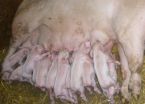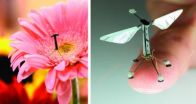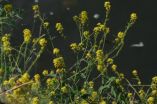(Press-News.org) Antibodies against C. suis are transferred via the sow's very first milk to the piglets immediately after birth. This was discovered by veterinarian and parasitologist Lukas Schwarz and his colleagues in 2013. These findings prompted the researchers at the Institute for Parasitology to look for a way to increase the level of these antibodies in sows. The ultimate goal was to provide the piglets with as much antibodies as possible via their mother's milk during the first few days of life.
Piglets from infected mothers are healthier
The idea paid off. Piglets from infected sows suffered less from the infection than piglets from non-infected sows. Overall offspring from immunised mothers had less severe diarrhoea or no diarrhoea at all. Piglets that became ill recovered faster and excreted fewer parasites compared to those from non-immunised sows.
"An infection with Cystoisospora suis causes serious gastrointestinal disease in piglets. The infection is continues completely asymptomatic in adult pigs", explains lead author Schwarz.
Sows produce antibodies for their offspring
To stimulate antibody production against Cystoisospora suis in sows, researchers exposed pregnant sows to infectious stages (oocysts) of the parasite two weeks before parturition. Oocysts as the primarily infectious stage stick to the floor and other objects in the farrowing barns. Piglets ingest them and the parasite colonizes the gut, attacking the mucous membrane. The parasites multiply in the body before being excreted and the cycle starts again. Cystoisospora suis can survive in pigsties for a number of months and is very hard to kill. This leaves farmers faced with the likelihood of new infections. Sows also ingest the parasite, but due to age resistance they are not affected by this coccidian parasite.
High concentrations of antibodies against the parasites are passed on to the piglets in the first few hours of life through their mother's milk, where they enter the blood stream and the intestines of the newborns who cannot yet produce their own antibodies. These maternal antibodies protect the piglets from infections in the first few weeks of life. The higher the concentration of antibodies in the sow's milk, the better protected her offspring are.
More antibodies mean less diarrhoea
Piglets with milder symptoms showed higher concentrations of IgA in their blood. These immunoglobulins are not just in the bloodstream, they are primarily found on the surface of the mucous membranes including the intestines where they serve as a defence against pathogens. Researchers found equally high levels of IgA in the blood of the infected mothers. "To date it has been assumed that immunoglobulins do not play a role in the course of swine coccidiosis. Our results provide the first indications that immunoglobulins could actually be quite important. Additional studies are required to identify the exact role played by the antibodies", Schwarz explains.
Protective milk as the basis for a vaccine
Researchers found particularly high concentrations of IgA in the very first milk known as colostrum, a highly nutritious milk all mammals ingest during the first days of life. This form of "milk vaccination" might serve as a basis for developing an immunisation strategy to prevent swine coccidiosis.
"There are some effective medications for swine coccidiosis, but we would like to use the piglet's immune response to stop it in its tracks before the infection even gets started," lead author Lukas Schwarz concludes.
The importance of Cystoisospora suis
Neonatal porcine coccidiosis caused by Cystosisospora suis is a severe parasitic disease of the intestinal tract of neonatal piglets caused by the unicellular organism Cystoisospora suis. Coccidiosis is associated with extensive destruction of the gut mucosa and thus with reduced food conversion, causing decreased weight gain and economic losses for farmers. Infection with Cystoisospora suis results in heavy diarrhoea and may cause fatalities if secondary bacterial infections are present. For animal welfare considerations as well as for economic reasons there is considerable interest in trying to control the disease.
INFORMATION:
The article „Superinfection of sows with Cystoisospora suis ante partum leads to a milder course of cystoisosporosis in suckling piglets", by Lukas Schwarz, Hanna Lucia Worliczek, Max Winkler and Anja Joachim was published in the journal Veterinary Parasitology. http://dx.doi.org/10.1016/j.vetpar.2014.04.026
About the University of Veterinary Medicine, Vienna
The University of Veterinary Medicine, Vienna in Austria is one of the leading academic and research institutions in the field of Veterinary Sciences in Europe. About 1,200 employees and 2,300 students work on the campus in the north of Vienna which also houses five university clinics and various research sites. Outside of Vienna the university operates Teaching and Research Farms. http://www.vetmeduni.ac.at
Scientific Contact:
Dr. Lukas Schwarz
University Clinic for Swine
University of Veterinary Medicine Vienna (Vetmeduni Vienna)
T +43 1 25077-6848
lukas.schwarz@vetmeduni.ac.at
Released by:
Susanna Kautschitsch
Science Communication / Public Relations
University of Veterinary Medicine Vienna (Vetmeduni Vienna)
T +43 1 25077-1153
susanna.kautschitsch@vetmeduni.ac.at
The protective milk shot
How mother's milk protects piglets from parasite infections
2014-05-23
ELSE PRESS RELEASES FROM THIS DATE:
Nature inspires drones of the future
2014-05-23
Researchers have been taking tips from nature to build the next generation of flying robots.
Based on the mechanisms adopted by birds, bats, insects and snakes, 14 distinguished research teams have developed solutions to some of the common problems that drones could be faced with when navigating through an urban environment and performing novel tasks for the benefit of society.
Whether this is avoiding obstacles, picking up and delivering items or improving the take-off and landing on tricky surfaces, it is hoped the solutions can lead to the deployment of drones in ...
Rapid evolution aids spread of exotic plant species
2014-05-23
A team of Belgian biologists led by researchers at KU Leuven has provided the first genetic evidence that rapid evolution can help non-native plant species spread in new environments. Using samples of centuries-old herbaria and DNA analysis, the researchers reconstructed the genetic adaptations undergone by the Pyrenean rocket prior to its rapid spread in Belgium.
The Pyrenean rocket (Sisymbrium austriacum subsp. chrysanthum) is a plant that grows in the mountains of southern Europe and is particularly prevalent in the Pyrenees. The species was first reported in Belgium ...
Lack of plant diversity spurs cankerworm damage in cities
2014-05-23
Research from North Carolina State University finds that a lack of plant diversity is a key contributor to the widespread defoliation caused by cankerworms in cities, and highlights the role that increasing diversity can play in limiting future damage.
Fall cankerworms (Alsophila pometaria) are caterpillars that are native to the eastern United States and hatch in early spring. The cankerworms defoliate trees and other plants, eating new leaves as they emerge – which is both unsightly and can ultimately kill the plants.
"We see cankerworms doing more damage to trees ...
Flatland optics with graphene
2014-05-23
Researchers from CIC nanoGUNE, in collaboration with ICFO and Graphenea, introduce a platform technology based on optical antennas for trapping and controlling light with the one-atom-thick material graphene. The experiments show that the dramatically squeezed graphene-guided light can be focused and bent, following the fundamental principles of conventional optics. The work, published yesterday in Science, opens new opportunities for smaller and faster photonic devices and circuits.
Optical circuits and devices could make signal processing and computing much faster. ...
Bacterial adaptation contributes to pneumococcal threat in sickle cell disease patients
2014-05-23
Researchers have identified differences in the genetic code of pneumococcal bacteria that may explain why it poses such a risk to children with sickle cell disease and why current vaccines don't provide better protection against the infection. St. Jude Children's Research Hospital scientists led the study, which appeared earlier this month in the journal Cell Host & Microbe.
The findings will aid efforts to improve vaccine effectiveness and inform research into new ways to protect young sickle cell disease patients from life-threatening pneumococcal infections that can ...
Breakthrough in RSV research to help infected children
2014-05-23
Researchers at Le Bonheur Children's Hospital and the University of Tennessee Health Science Center announced results today from a clinical trial of a drug shown to safely reduce the viral load and clinical illness of healthy adult volunteers intranasally infected with respiratory syncytial virus (RSV).
Detailed results of this study were presented by lead researcher Infectious Disease Specialist John DeVincenzo, MD, this week during a poster discussion session at the American Thoracic Society 2014 International Conference in San Diego. He serves as medical director of ...
Argonne scientists discover new phase in iron-based superconductors
2014-05-23
Scientists at the U.S. Department of Energy's Argonne National Laboratory have discovered a previously unknown phase in a class of superconductors called iron arsenides. This sheds light on a debate over the interactions between atoms and electrons that are responsible for their unusual superconductivity.
"This new magnetic phase, which has never been observed before, could have significant implications for our understanding of unconventional superconductivity," said Ray Osborn, an Argonne physicist and coauthor on the paper.
Scientists and engineers are fascinated ...
Health-care professionals must be aware of rarer causes of headaches in pregnancy
2014-05-23
Most headaches in pregnancy and the postnatal period are benign, but healthcare professionals must be alert to the rarer and more severe causes of headaches, suggests a new review published today (23 May) in The Obstetrician & Gynaecologist (TOG).
The review looks at common causes for headaches during pregnancy and the postnatal period, possible conditions that may be associated with headaches and how healthcare professionals should manage the care of the woman appropriately.
There are 85 different types of headache. Approximately 90% of headaches in pregnancy are migraine ...
A study assesses the possibility of turning CO2 into methanol for use in transport
2014-05-23
Tecnalia has collaborated in a study for the European Parliament's Science and Technology Options Assessment Panel (STOA) on the future use of methanol, produced from carbon dioxide, in motorised transport. STOA is the panel that advises MEPs in the sphere of Science and Technology.
The study analysed the barriers –technological, environmental and economic– to producing methanol using carbon dioxide as well as the options that would allow possible uses in automobile transport in the medium and long term.
The costs and benefits were evaluated from the life cycle perspective ...
New sensor could light the way forward in low-cost medical imaging
2014-05-23
New research published today in Nature's Scientific Reports, identifies a new type of light sensor that could allow medical and security imaging, via low cost cameras.
The team of researchers from the University of Surrey have developed a new 'multispectral' light sensor that detects the full spectrum of light, from ultra-violet (UV), to visible and near infrared light.
Indeed, near infrared light can be used to perform non-invasive medical procedures, such as measuring the oxygen level in tissue and detecting tumours. It is also already commonly used in security camera ...
LAST 30 PRESS RELEASES:
What causes some people’s gut microbes to produce high alcohol levels?
Global study reveals widespread burning of plastic for heating and cooking
MIT study shows pills that communicate from the stomach could improve medication adherence
Searching for the centromere: diversity in pathways key for cell division
Behind nature’s blueprints
Researchers search for why some people’s gut microbes produce high alcohol levels
Researchers find promising new way to boost the immune response to cancer
Coffee as a staining agent substitute in electron microscopy
Revealing the diversity of olfactory receptors in hagfish and its implications for early vertebrate evolution
Development of an ultrasonic sensor capable of cuffless, non-invasive blood pressure measurement
Longer treatment with medications for opioid use disorder is associated with greater probability of survival
Strategy over morality can help conservation campaigns reduce ivory demand, research shows
Rising temperatures reshape microbial carbon cycling during animal carcass decomposition in water
Achieving ultra-low-power explosive jumps via locust bio-hybrid muscle actuators
Plant-derived phenolic acids revive the power of tetracycline against drug-resistant bacteria
Cooperation: A costly affair in bacterial social behaviour?
Viruses in wastewater: Silent drivers of pollution removal and antibiotic resistance
Sub-iethal water disinfection may accelerate the spread of antibiotic resistance
Three in four new Australian moms struggle with body image
Post-stroke injection protects the brain in preclinical study
Cardiovascular risk score predicts multiple eye diseases
Health: estimated one in ten British adults used or interested in GLP-1 medications for weight loss
Exercise to treat depression yields similar results to therapy
Whooping cough vaccination for pregnant women strengthens babies’ immune system
Dramatic decline in new cases of orphanhood in Uganda driven by HIV treatment and prevention programs
Stopping weight loss drugs linked to weight regain and reversal of heart health markers
Higher intake of food preservatives linked to increased cancer risk
Mass General Brigham–developed cholera vaccine completes phase 1 trial
First experimental validation of a “150-year-old chemical common sense” direct visualization of the molecular structural changes in the ultrafast anthracene [4+4] photocycloaddition reaction
Lack of support for people on weight loss drugs leaves them vulnerable to nutritional deficiencies, say experts
[Press-News.org] The protective milk shotHow mother's milk protects piglets from parasite infections




